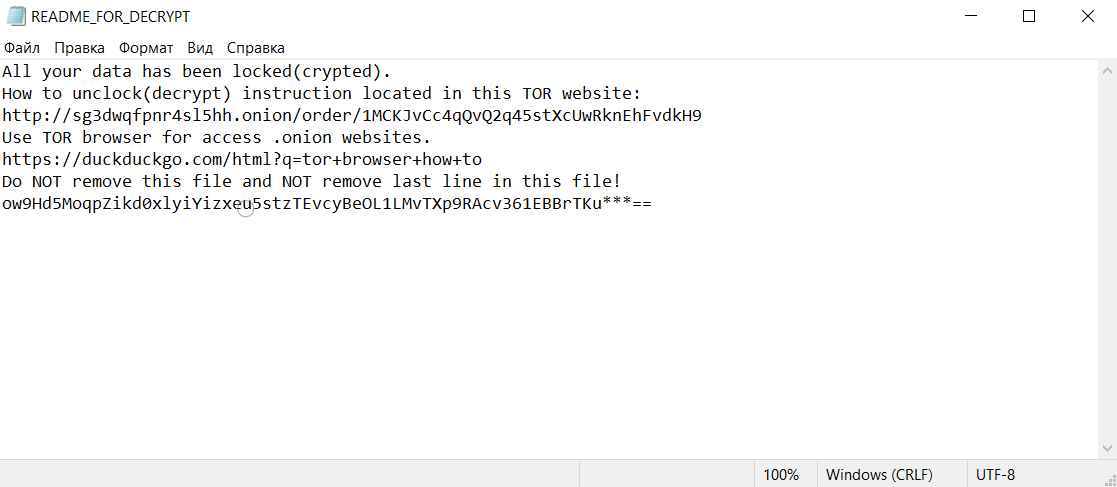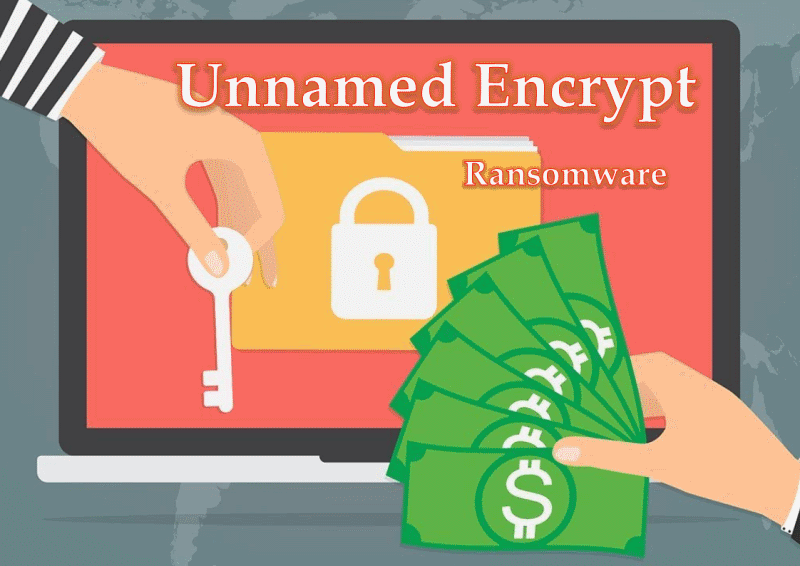What is Unnamed Encrypt Ransomware?
Unnamed Encrypt Ransomware is a regular cryptovirus that aims to encrypt user files of various formats and types, for example, office documents, audio, video, multimedia, archives and much more. Encryption is performed using the AES algorithm. The greatest activity of this crypto-extortioner was identified in mid-June 2019. It is worth noting that the cryptovirus was originally written for English-speaking users, however, in a matter of days, Unnamed Encrypt has spread around the world, so more and more users want to remove Unnamed Encrypt Ransomware and decrypt .encrypt files. The virus changes the file extension to .encrypt, as a result of which the files finally become non-usable. Below we have placed the image and content of the scam text message contained in the README_FOR_DECRYPT.txt file:

All your data has been locked(crypted).
How to unclock(decrypt) instruction located in this TOR website: http://sg3dwqfpnr4sl5hh.onion/order/1MCKJvCc4qQvQ2q45stXcUwRknEhFvdkH9
Use TOR browser for access .onion websites.
https://duckduckgo.com/html?q=tor+browser+how+to
Do NOT remove this file and NOT remove last line in this file!
ow9Hd5MoqpZikd0xlyiYizxeu5stzTEvcyBeOL1LMvTXp9RAcv361EBBrTKu***==
The note contains a reference to the .onion extension, which was also indicated in the note from the developers of the 23qp1 Ransomware. This may indicate that Unnamed Encrypt belongs to a particular family, for example, the Orion Ransomware family. Fraudsters indicate the only possible decryption option – payment of ransom. To do this, the user must go to the specified link, using the Tor browser. The purchase itself must be made in bitcoins. By the way, the cryptocurrency is not chosen by chance, because only in this way can fraudsters hide their location, since cryptocurrency transactions are practically not traceable. We do not recommend you pay intruders. The best solution is to try to remove Unnamed Encrypt Ransomware using special helpful programs and decrypt .encrypt files.
Update: Use following service to identify the version and type of ransomware you were attacked by: ID Ransomware. If you want to decrypt your files, please follow our instruction below or, if you have any difficulties, please contact us: submit@securitystronghold.com. We really can help to decrypt your files.
How to remove Unnamed Encrypt from your computer?
You may try to use anti-malware tool to remove Unnamed Encrypt ransomware from your computer. Newly advanced ransomware detection technology is able to run an instant ransomware scan, which is perfect to protect your computer in case of a new ransomware attack.
SpyHunter provides an opportunity to remove 1 detected malware for free during trial period. The full version of the program costs $39,99 (you get 6 months of subscription). By clicking the button you agree to EULA and Privacy Policy. Downloading will start automatically.
How to decrypt .Unnamed Encrypt files?
Once you’ve removed the virus, you are probably thinking of recovering files from encryption. Let’s take a look at possible ways of decrypting your data.
Recover data with Data Recovery

- Download and install Data Recovery
- Select drives and folders with your files, then click Scan.
- Choose all the files in a folder, then press on Restore button.
- Manage export location.
Restore data with automated decryption tools
Unfortunately, due to the novelty of Unnamed Encrypt ransomware, there are no available automatic decryptors for this encryptor yet. Still, there is no need to invest in the malicious scheme by paying a ransom. You are able to recover files manually.
You can try to use one of these methods in order to restore your encrypted data manually.
Restore data with Windows Previous Versions
This feature is working on Windows Vista (not Home version), Windows 7 and later versions. Windows saves copies of files and folders which you can use to restore data on your computer. In order to restore data from Windows Backup, take the following steps:
- Open My Computer and search for the folders you want to restore;
- Right-click on the folder and choose Restore previous versions option;
- The option will show you the list of all the previous copies of the folder;
- Select restore date and the option you need: Open, Copy and Restore.
Restore the system with System Restore
You can always try to use System Restore in order to roll back your system to its condition before infection infiltration. All the Windows versions include this option.
- Type restore in the Search tool;
- Click on the result;
- Choose restore point before the infection infiltration;
- Follow the on-screen instructions.
Written by Rami D

